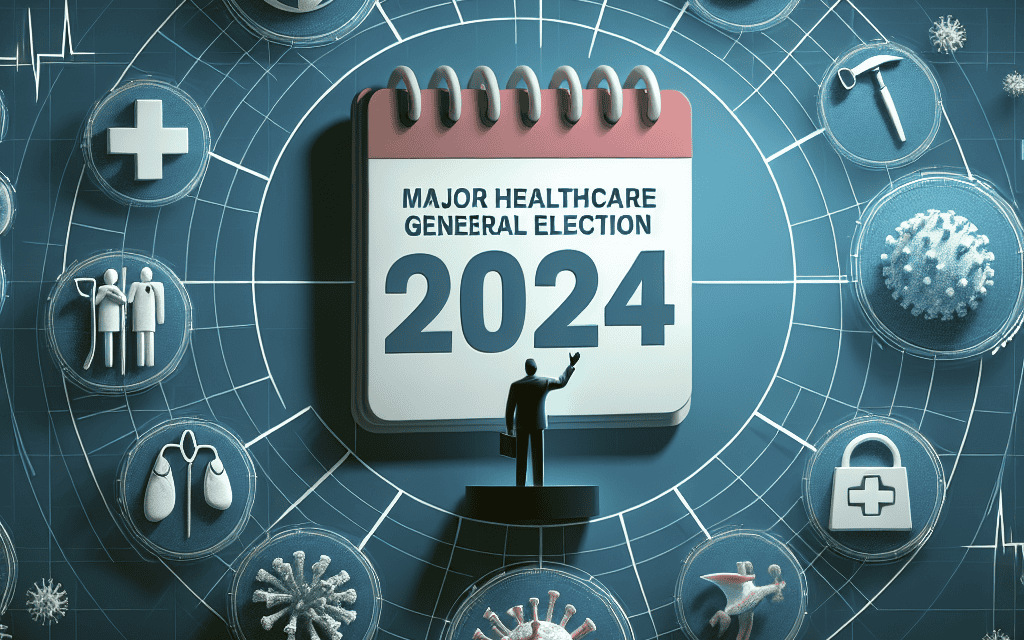“Navigating Tomorrow’s Health: Addressing Critical Challenges in the 2024 Election”
Introduction
As the 2024 election approaches, the United States faces a myriad of healthcare challenges that are poised to dominate the political discourse. The ongoing struggle to balance cost, access, and quality of care remains at the forefront, with rising healthcare expenses continuing to burden both individuals and the national economy. The COVID-19 pandemic has further exposed and exacerbated existing disparities in healthcare access and outcomes, particularly among marginalized communities. Additionally, the mental health crisis, fueled by the pandemic’s social and economic impacts, demands urgent attention and resources. The debate over healthcare policy is also intensified by the need to address the opioid epidemic, the integration of telehealth services, and the sustainability of Medicare and Medicaid. As candidates outline their platforms, voters are keenly aware that the next administration’s approach to these pressing issues will have profound implications for the nation’s health and well-being.
Rising Healthcare Costs
As the 2024 election approaches, the issue of rising healthcare costs remains a pivotal concern for both policymakers and the general public. The escalating expenses associated with healthcare have far-reaching implications, affecting not only individual households but also the broader economic landscape. Understanding the multifaceted nature of this challenge is crucial for developing effective strategies to address it.
To begin with, the increasing cost of healthcare is largely driven by several interrelated factors. One of the primary contributors is the high price of prescription drugs. Pharmaceutical companies often justify these prices by citing the substantial investment required for research and development. However, this explanation does little to alleviate the financial burden on consumers, many of whom struggle to afford necessary medications. Consequently, there is a growing demand for policy interventions that can balance the need for innovation with the imperative of affordability.
In addition to drug prices, the cost of medical services continues to rise. Hospitals and healthcare providers face mounting operational expenses, which are often passed on to patients in the form of higher fees. This situation is exacerbated by the complexity of the healthcare system, where administrative costs consume a significant portion of healthcare spending. Streamlining administrative processes and improving efficiency could potentially reduce these costs, yet achieving such reforms requires coordinated efforts across various sectors.
Moreover, the demographic shift towards an aging population further complicates the issue of rising healthcare costs. As life expectancy increases, so does the prevalence of chronic conditions that require long-term management. This trend places additional strain on healthcare systems, necessitating more resources and specialized care. Policymakers must therefore consider strategies that not only address immediate cost concerns but also anticipate future demands on the healthcare infrastructure.
Transitioning to the role of insurance, it is evident that the structure of health insurance plans significantly impacts overall healthcare costs. High-deductible plans, while intended to lower premiums, often result in higher out-of-pocket expenses for consumers. This can deter individuals from seeking necessary care, ultimately leading to more severe health issues and higher costs in the long run. Thus, there is a pressing need to evaluate and potentially reform insurance models to ensure they provide adequate coverage without imposing prohibitive costs on policyholders.
Furthermore, the intersection of technology and healthcare presents both opportunities and challenges in managing rising costs. On one hand, technological advancements have the potential to improve patient outcomes and streamline care delivery. On the other hand, the integration of new technologies often involves significant upfront investments and ongoing maintenance expenses. Balancing these costs with the benefits of innovation is a delicate task that requires careful consideration and strategic planning.
As the election draws near, it is imperative for candidates to articulate clear and actionable plans to address the issue of rising healthcare costs. Voters are increasingly concerned about the financial strain of healthcare, and they seek solutions that are both sustainable and equitable. By prioritizing transparency, efficiency, and accessibility, policymakers can work towards a healthcare system that better serves the needs of all citizens.
In conclusion, the challenge of rising healthcare costs is a complex issue that demands a multifaceted approach. By understanding the underlying factors and exploring innovative solutions, there is potential to alleviate the financial burden on individuals and create a more sustainable healthcare system. As the 2024 election approaches, this issue will undoubtedly remain at the forefront of public discourse, shaping the policies and priorities of future leaders.
Access to Affordable Insurance
As the 2024 election approaches, the issue of access to affordable insurance remains a pivotal concern for many Americans. The healthcare landscape in the United States has long been characterized by its complexity and high costs, which continue to pose significant challenges for individuals seeking coverage. Despite various reforms and policy initiatives over the years, the quest for affordable insurance remains elusive for a substantial portion of the population. This ongoing struggle is exacerbated by several factors that intertwine to create a multifaceted problem.
Firstly, the rising cost of healthcare services is a primary driver of expensive insurance premiums. Medical advancements, while beneficial, often come with hefty price tags that are reflected in the cost of insurance plans. As new treatments and technologies emerge, insurance companies adjust their pricing models to accommodate these innovations, leading to higher premiums for consumers. Consequently, many individuals find themselves priced out of the market, unable to afford the coverage they need. This situation is particularly dire for those with pre-existing conditions, who may face even steeper costs due to their increased risk profile.
Moreover, the disparity in healthcare access between different socioeconomic groups further complicates the issue. Low-income individuals and families are disproportionately affected by the high cost of insurance, as they often lack the financial resources to pay for comprehensive coverage. While government programs like Medicaid aim to bridge this gap, eligibility requirements and funding limitations can leave many without adequate support. This inequity is a critical concern as policymakers seek to create a more inclusive healthcare system that ensures all citizens have access to necessary medical services.
In addition to economic barriers, geographic disparities also play a significant role in access to affordable insurance. Rural areas, in particular, face unique challenges due to a scarcity of healthcare providers and facilities. This shortage not only limits the availability of services but also drives up costs, as residents may need to travel long distances to receive care. Insurance plans in these regions often reflect the increased expenses associated with limited access, further burdening individuals who already face financial constraints.
As the election draws near, candidates are under pressure to address these pressing issues and propose viable solutions. The debate over healthcare reform is likely to be a central theme, with various approaches being put forward to tackle the problem of affordability. Some advocate for expanding existing programs like the Affordable Care Act, while others propose more radical changes, such as implementing a single-payer system. Each of these options carries its own set of challenges and implications, making it crucial for voters to carefully consider the potential impact on their access to insurance.
Furthermore, the role of private insurance companies in the healthcare system is a contentious topic that will undoubtedly influence the discourse. Balancing the interests of these entities with the need to provide affordable coverage for all is a delicate task that requires thoughtful policy design and implementation. As discussions unfold, it is essential to recognize the complexity of the issue and the need for comprehensive strategies that address the root causes of high insurance costs.
In conclusion, access to affordable insurance remains a significant challenge as the 2024 election approaches. The interplay of rising healthcare costs, socioeconomic disparities, and geographic limitations creates a complex environment that demands careful consideration and innovative solutions. As candidates present their visions for the future of healthcare, the electorate will play a crucial role in shaping the policies that will determine the accessibility and affordability of insurance for years to come.
Prescription Drug Pricing
As the 2024 election approaches, the issue of prescription drug pricing remains a pivotal concern for both policymakers and the public. The escalating costs of medications have long been a contentious topic, with many Americans struggling to afford essential prescriptions. This challenge is compounded by the complex interplay of pharmaceutical companies, insurance providers, and government regulations, which together create a labyrinthine system that often leaves patients bearing the financial burden.
To understand the intricacies of prescription drug pricing, it is essential to consider the role of pharmaceutical companies. These entities are responsible for the research, development, and marketing of new drugs, a process that is both time-consuming and costly. While the innovation of new medications is crucial for advancing healthcare, the high costs associated with bringing a drug to market are often passed on to consumers. Consequently, patients frequently face exorbitant prices for life-saving medications, a situation that has sparked widespread calls for reform.
In response to public outcry, policymakers have proposed various strategies to address the issue of high drug prices. One such approach is the implementation of price controls, which would limit the amount that pharmaceutical companies can charge for their products. Proponents argue that this would make medications more affordable for consumers, while critics contend that it could stifle innovation by reducing the financial incentives for developing new drugs. This debate highlights the delicate balance that must be struck between ensuring access to affordable medications and fostering an environment conducive to pharmaceutical innovation.
Another potential solution lies in increasing transparency within the drug pricing system. By requiring pharmaceutical companies to disclose the costs associated with developing and manufacturing their products, policymakers hope to shed light on the factors driving high prices. This increased transparency could empower consumers to make more informed decisions about their healthcare and encourage competition among drug manufacturers, ultimately leading to lower prices. However, the effectiveness of this approach remains uncertain, as the complex nature of the pharmaceutical industry may obscure the true impact of such measures.
In addition to these domestic efforts, international comparisons have also been drawn in the debate over prescription drug pricing. Many countries, particularly those with single-payer healthcare systems, are able to negotiate lower drug prices on behalf of their citizens. This has led some to advocate for similar strategies in the United States, such as allowing Medicare to negotiate directly with pharmaceutical companies. While this proposal has garnered significant support, it faces opposition from those who argue that it could disrupt the market dynamics that drive innovation.
As the election draws nearer, the issue of prescription drug pricing is likely to remain at the forefront of healthcare discussions. Voters are increasingly demanding action from their elected officials, and candidates are under pressure to present viable solutions to this pressing problem. The challenge lies in crafting policies that balance the need for affordable medications with the imperative to sustain a robust pharmaceutical industry. Ultimately, the outcome of this debate will have far-reaching implications for the future of healthcare in the United States, affecting not only the cost of medications but also the accessibility and quality of care for millions of Americans. As such, it is imperative that policymakers approach this issue with both urgency and nuance, ensuring that the solutions they propose are both effective and equitable.
Mental Health Crisis

As the 2024 election approaches, the mental health crisis in the United States remains a pressing issue that demands urgent attention from policymakers and candidates alike. The pandemic has exacerbated existing mental health challenges, revealing significant gaps in the healthcare system that require comprehensive solutions. With mental health disorders affecting millions of Americans, the need for effective strategies to address this crisis has never been more critical.
One of the primary challenges in tackling the mental health crisis is the persistent stigma surrounding mental illness. Despite increased awareness, many individuals still hesitate to seek help due to fear of judgment or discrimination. This stigma not only affects those suffering from mental health issues but also influences public policy and funding decisions. As the election draws near, candidates must prioritize destigmatization efforts, promoting mental health as an integral component of overall well-being.
In addition to stigma, access to mental health services remains a significant barrier for many Americans. Rural areas, in particular, face a shortage of mental health professionals, leaving residents with limited options for care. Even in urban settings, long wait times and high costs can deter individuals from seeking treatment. To address these disparities, policymakers must consider expanding telehealth services, which have proven effective in increasing access to care during the pandemic. By leveraging technology, mental health services can reach underserved populations, providing timely and affordable support.
Moreover, the integration of mental health services into primary care settings is essential for early intervention and comprehensive treatment. Many individuals first present mental health symptoms to their primary care providers, yet these professionals often lack the resources or training to address such issues adequately. By fostering collaboration between mental health specialists and primary care providers, the healthcare system can offer more holistic care, improving outcomes for patients.
Another critical aspect of the mental health crisis is the intersection with substance use disorders. The opioid epidemic, compounded by the pandemic, has led to a surge in substance abuse, further straining mental health resources. Addressing this dual crisis requires a multifaceted approach, including increased funding for addiction treatment programs and the implementation of harm reduction strategies. As candidates outline their healthcare platforms, they must recognize the interconnectedness of mental health and substance use, advocating for policies that address both issues simultaneously.
Furthermore, the mental health crisis disproportionately affects marginalized communities, including people of color, LGBTQ+ individuals, and low-income populations. These groups often face additional barriers to accessing care, such as cultural stigma, discrimination, and financial constraints. To ensure equitable mental health support, policymakers must prioritize culturally competent care and invest in community-based programs that cater to the unique needs of these populations.
As the 2024 election nears, it is imperative that candidates address the mental health crisis with comprehensive and inclusive policies. By prioritizing destigmatization, expanding access to care, integrating services, addressing substance use disorders, and ensuring equity, the next administration can make significant strides in improving mental health outcomes for all Americans. The mental health crisis is a complex issue that requires a concerted effort from all levels of government, healthcare providers, and communities. As voters consider their choices, the candidates’ commitment to addressing this critical challenge will undoubtedly play a pivotal role in shaping the future of healthcare in the United States.
Healthcare Workforce Shortages
As the 2024 election approaches, the issue of healthcare workforce shortages has emerged as a critical concern for policymakers, healthcare providers, and the public alike. This challenge, which has been exacerbated by the COVID-19 pandemic, is multifaceted and requires a comprehensive understanding of its underlying causes and potential solutions. The shortage of healthcare professionals, including doctors, nurses, and allied health workers, poses significant risks to the quality and accessibility of care, making it a pressing issue on the national agenda.
To begin with, the aging population in the United States is a primary driver of increased demand for healthcare services. As the baby boomer generation continues to age, the need for medical care, particularly for chronic conditions, is rising. This demographic shift places an unprecedented strain on the existing healthcare workforce, which is already stretched thin. Moreover, the retirement of experienced healthcare professionals further compounds the problem, as it leads to a loss of valuable expertise and mentorship for younger practitioners.
In addition to demographic changes, the healthcare sector is grappling with the effects of burnout among its workforce. The pandemic has highlighted and intensified the stress and emotional toll faced by healthcare workers, leading to higher rates of burnout and attrition. This phenomenon not only affects the well-being of healthcare professionals but also impacts patient care, as overworked staff may struggle to maintain the high standards of care that patients expect and deserve. Consequently, addressing burnout is essential to retaining existing staff and attracting new talent to the field.
Furthermore, geographic disparities in healthcare access contribute to workforce shortages. Rural and underserved urban areas often face significant challenges in attracting and retaining healthcare professionals. These regions may lack the resources and infrastructure necessary to support a robust healthcare system, leading to gaps in care and poorer health outcomes for residents. To mitigate these disparities, targeted incentives and support for healthcare providers in these areas are crucial.
In response to these challenges, several strategies have been proposed to bolster the healthcare workforce. Expanding educational opportunities and training programs is one such approach. By increasing the capacity of medical and nursing schools, as well as offering scholarships and loan forgiveness programs, more individuals may be encouraged to pursue careers in healthcare. Additionally, leveraging technology, such as telemedicine, can help alleviate some of the pressures on the workforce by enabling remote consultations and reducing the need for in-person visits.
Moreover, policy interventions at the federal and state levels are essential to address systemic issues contributing to workforce shortages. This includes reforming reimbursement models to ensure fair compensation for healthcare providers, particularly in primary care and rural settings. Additionally, fostering a supportive work environment through policies that promote work-life balance and mental health support can help reduce burnout and improve job satisfaction among healthcare workers.
As the 2024 election draws near, it is imperative for candidates and policymakers to prioritize solutions to healthcare workforce shortages. By addressing the root causes of this issue and implementing effective strategies, the United States can work towards a more resilient and equitable healthcare system. Ultimately, ensuring a sufficient and well-supported healthcare workforce is not only vital for meeting the current and future needs of the population but also for safeguarding the nation’s overall health and well-being.
Health Equity and Disparities
As the 2024 election approaches, healthcare remains a pivotal issue, with health equity and disparities at the forefront of national discourse. The United States, despite its advanced medical technology and significant healthcare expenditure, continues to grapple with profound inequities that affect millions of Americans. These disparities are not only a matter of social justice but also a significant public health concern, as they contribute to poorer health outcomes and increased healthcare costs.
One of the primary challenges in addressing health disparities is the persistent gap in access to healthcare services. This gap is often exacerbated by socioeconomic factors, including income, education, and employment status, which disproportionately affect minority communities. For instance, individuals from low-income backgrounds or those living in rural areas frequently encounter barriers such as a lack of nearby healthcare facilities, transportation issues, and insufficient health insurance coverage. These obstacles hinder their ability to receive timely and adequate medical care, leading to preventable illnesses and complications.
Moreover, racial and ethnic disparities in healthcare access and outcomes remain a critical issue. Studies have consistently shown that minority groups, particularly African Americans, Hispanics, and Native Americans, experience higher rates of chronic conditions such as diabetes, hypertension, and heart disease. These disparities are often rooted in systemic issues, including historical discrimination, implicit bias within the healthcare system, and social determinants of health that limit opportunities for healthy living. Addressing these challenges requires a multifaceted approach that includes policy reforms, community engagement, and targeted interventions to ensure equitable access to healthcare services.
In addition to access, the quality of care received by different populations is another area of concern. Research indicates that minority patients often receive lower-quality care compared to their white counterparts, even when they have similar insurance coverage and socioeconomic status. This discrepancy can be attributed to factors such as provider bias, communication barriers, and a lack of cultural competence among healthcare professionals. To mitigate these issues, it is essential to implement training programs that enhance cultural awareness and sensitivity among healthcare providers, as well as to promote diversity within the healthcare workforce.
Furthermore, the COVID-19 pandemic has highlighted and, in many cases, exacerbated existing health disparities. The virus has disproportionately affected minority communities, both in terms of infection rates and mortality. This disparity is largely due to pre-existing health conditions, crowded living situations, and employment in essential jobs that increase exposure risk. The pandemic has underscored the urgent need for comprehensive public health strategies that address the root causes of health inequities and ensure that all communities are adequately protected and supported.
As policymakers and stakeholders prepare for the upcoming election, it is crucial to prioritize health equity in the national healthcare agenda. This involves not only addressing the immediate challenges posed by disparities in access and quality of care but also tackling the broader social determinants that contribute to these inequities. By fostering collaboration between government agencies, healthcare providers, and community organizations, it is possible to create a more equitable healthcare system that serves the needs of all Americans.
In conclusion, as the 2024 election draws near, the issue of health equity and disparities demands urgent attention. By acknowledging and addressing the complex factors that contribute to these challenges, the United States can move towards a more just and effective healthcare system. This will not only improve health outcomes for marginalized populations but also enhance the overall health and well-being of the nation.
Impact of Climate Change on Public Health
As the 2024 election approaches, the intersection of climate change and public health emerges as a critical issue demanding attention from policymakers and the public alike. The impact of climate change on public health is multifaceted, affecting various aspects of human well-being and necessitating comprehensive strategies to mitigate its adverse effects. Understanding these challenges is essential for informed decision-making and effective policy formulation.
To begin with, climate change has been linked to an increase in the frequency and intensity of extreme weather events, such as hurricanes, heatwaves, and floods. These events pose immediate threats to human health, causing injuries, fatalities, and the displacement of communities. For instance, heatwaves can lead to heat-related illnesses and exacerbate pre-existing health conditions, particularly among vulnerable populations such as the elderly and those with chronic illnesses. Moreover, flooding can result in waterborne diseases and disrupt access to essential healthcare services, further complicating public health responses.
In addition to extreme weather events, climate change also influences the distribution and prevalence of infectious diseases. Rising temperatures and changing precipitation patterns can expand the habitats of vectors such as mosquitoes and ticks, facilitating the spread of diseases like malaria, dengue fever, and Lyme disease. This shift not only increases the burden on healthcare systems but also necessitates the development of new strategies for disease prevention and control. Consequently, public health infrastructure must adapt to these emerging threats, requiring investment in surveillance systems, research, and healthcare workforce training.
Furthermore, climate change impacts air quality, which has direct implications for respiratory health. Increased levels of pollutants, such as ground-level ozone and particulate matter, can exacerbate respiratory conditions like asthma and chronic obstructive pulmonary disease (COPD). The health effects of poor air quality are particularly pronounced in urban areas, where populations are denser and exposure levels are higher. Addressing air quality issues requires coordinated efforts to reduce emissions from industrial sources, transportation, and other contributors to air pollution.
Transitioning to another significant concern, climate change also affects food security and nutrition, which are vital components of public health. Changes in temperature and precipitation patterns can disrupt agricultural productivity, leading to food shortages and increased prices. These disruptions can result in malnutrition, particularly in low-income communities that are already vulnerable to food insecurity. Ensuring access to nutritious food in the face of climate change requires innovative approaches to agriculture, such as the development of climate-resilient crops and sustainable farming practices.
Moreover, mental health is an often-overlooked aspect of the climate change-public health nexus. The psychological impacts of climate-related events, such as natural disasters and displacement, can lead to increased rates of anxiety, depression, and post-traumatic stress disorder (PTSD). Addressing these mental health challenges necessitates the integration of mental health services into disaster response and recovery efforts, as well as broader public health initiatives.
In conclusion, the impact of climate change on public health presents a complex array of challenges that require urgent attention as the 2024 election approaches. Policymakers must prioritize the development of adaptive strategies that address the immediate and long-term health effects of climate change. By investing in resilient healthcare systems, promoting sustainable practices, and fostering international collaboration, it is possible to mitigate the public health impacts of climate change and safeguard the well-being of current and future generations.
Q&A
1. **Rising Healthcare Costs**: The increasing cost of healthcare services, insurance premiums, and prescription drugs remains a significant concern for voters and policymakers.
2. **Access to Care**: Disparities in access to healthcare, particularly in rural and underserved urban areas, continue to challenge the healthcare system.
3. **Medicare and Medicaid Sustainability**: Ensuring the long-term sustainability of Medicare and Medicaid programs amidst an aging population and budget constraints is a pressing issue.
4. **Mental Health and Substance Abuse**: Addressing the growing mental health crisis and the opioid epidemic requires comprehensive policy solutions and increased funding.
5. **Healthcare Workforce Shortages**: Shortages of healthcare professionals, including doctors, nurses, and support staff, are impacting the quality and availability of care.
6. **Public Health Preparedness**: Strengthening public health infrastructure and preparedness for future pandemics or health emergencies is a critical concern.
7. **Health Equity**: Tackling health disparities based on race, ethnicity, income, and geography to ensure equitable healthcare outcomes for all populations.
Conclusion
As the 2024 election approaches, key healthcare challenges include addressing the rising costs of medical care and prescription drugs, which continue to burden individuals and the healthcare system. Access to affordable healthcare remains a critical issue, with debates over the future of the Affordable Care Act and potential reforms to expand coverage. Mental health services and the opioid crisis demand urgent attention, requiring comprehensive strategies to improve treatment and support. Additionally, the healthcare workforce faces shortages and burnout, exacerbated by the COVID-19 pandemic, necessitating policies to bolster recruitment, retention, and training. Health equity is another pressing concern, with disparities in care and outcomes persisting across racial, ethnic, and socioeconomic lines. As these challenges intersect with broader economic and social issues, they will likely play a significant role in shaping the policy priorities and electoral strategies of candidates in the upcoming election.





